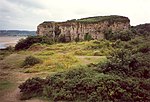St Mary's Church, Pentraeth is a small medieval parish church in the village of Pentraeth, in Anglesey, north Wales. The date of construction is unknown, but is probably from some time between the 12th to 14th centuries. A church dedicated to St Mary was recorded here in 1254, but there is a tradition that there was an older church dedicated to St Geraint, an early British saint. Some medieval stonework remains in three walls of the building (the west wall, and parts of the north and south walls). A chapel was added to the south side in the 16th or 17th century. The church was altered and refurbished during the 19th century, including an extensive rebuilding by Henry Kennedy, the architect for the Diocese of Bangor, in 1882. St Mary's is still used for worship by the Church in Wales, and is one of three churches in a combined parish. Its conservation is specifically included in the aims of a Chester-based charity that promotes health and the arts in Anglesey and the north-west of England.
It is a Grade II listed building, a national designation given to "buildings of special interest, which warrant every effort being made to preserve them", in particular because of the retention of medieval fabric in a predominately 19th-century building, and its "fine" memorials. It is built from rubble masonry with a slate roof, and part of a font thought to date from the 12th century has been reused as a water basin in the porch. St Mary's has a number of memorials from the 18th and 19th centuries, some commemorating residents of a nearby manor house. There was once a tradition of decorating the interior with paper garlands, although writers differ on whether this was to celebrate parishioners' weddings or to mark the death of unmarried women. It was one of only two churches in Anglesey included by the 18th-century writer Francis Grose in his multi-volume guide to English and Welsh antiquities.







